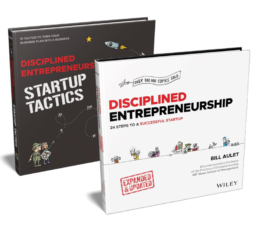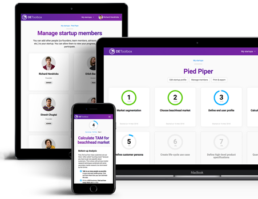Step 18
Scalable Revenue Engine
Mapping your Scalable Revenue Engine is a thoughtful first pass at how you will enter the market, refine your sales strategy over time, and ultimately establish a sustainable long-term strategy for customer acquisition.
The Scalable Revenue Engine includes creating awareness, educating the customer, and handling and processing the sale. The Scalable Revenue Engine drives the CoCA, one of the variables—along with the LTV—that shows your business’s profitability.
Remember, a business is about getting paying customers and you have to respect the sales, or more appropriately now, revenue generation process. Don’t give this step less attention. It is critically important to build up your knowledge of this part of your business. This is where many of the most important adjustments in your plan will be made, so understanding the levers to pull is mission-critical.
Videos
There are no individual videos for this step alone, but rather the materials are integrated into the videos referenced in Step 19 CoCA.
Worksheets
Examples
Content will be published as it becomes available.
Topics
Process Guide
To map your sales process, you will start by determining for the short, medium, and long term what proportion of sales will come from different channels. Use the Sales Channels for the Short, Medium, and Long Term worksheet to define the periods of time and proportions, as well as sales goals to achieve during that period, and assumptions and risks involved. You will also define what milestones you need to reach during each period so that your company is prepared to shift to the sales strategy for the next period.
Short-term, medium-term, and long-term are defined in large part by the progress you make on your product. In the short term, you are figuring out what your product is and creating demand; in the medium term you are refining your product and starting to produce it in a repeatable fashion, fulfilling demand, and building the manufacturing and sales infrastructure you need to be successful; and in the long term, you are scaling your business. The key is that you define and understand what milestones allow you to shift your approach from the short-term sales channels to the medium-term to the long-term. Typically, short-term will map to the first year from your LTV calculation, medium-term the second year, and long-term the third year and beyond, but this may differ if your product has significantly longer or shorter development cycles, such as new pharmaceutical development.
Next, you will take the sales funnel work you did in Step 13 and refine it into second draft sales funnels, one for each of the short-term, medium-term, and long-term time periods. Now that you know which sales channels are viable—and more importantly, not viable—for the long term, you have enough information to be much more specific than in your original draft from Step 13. Like everything, you will continue refining your sales funnels over time.
You’ll also think through what techniques and actions you can use to maximize conversion between steps. Be creative and draw on the work you’ve done so far in the 24 steps as well as ideas from other companies and industries. At the end of this chapter, I’ve provided an example from one of my student teams to inspire you.
A disclaimer: These worksheets are comprehensive and may be overdesigned for your situation. Or, if you have a complicated, multisided market, they may be under-designed. Use common sense and customize this framework to fit your customer/product scenario. For instance, if you are business-to-consumer (B2C), some of this detail is not necessary, though I would argue it is still good for you to go through all the details so that you fully understand the big picture. Knowledge is a good thing—if you have the time.
Books
Content will be published as it becomes available.
Other Resources
Content will be published as it becomes available.
The Disciplined Entrepreneurship Toolbox
Stay ahead by using the 24 steps together with your team, mentors, and investors.
The books
This methodology with 24 steps and 15 tactics was created at MIT to help you translate your technology or idea into innovative new products. The books were designed for first-time and repeat entrepreneurs so that they can build great ventures.

